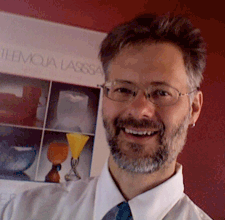Pilgrim Reindeer in Pisa, 1348
a free multimedia novel by
Thomas A. DuBois, University of Wisconsin-Madison
 |
Pilgrim Reindeer in Pisa, 1348 a free multimedia novel by Thomas A. DuBois, University of Wisconsin-Madison |
|
|
|
Part III. Italy. 54. The Road to Assisi [April 23, 1348]
This chapter has a lot to do with symmetry. I revisit the idea of Bávlos making a piece of art as a gift for Buonamico, along with Buonamico's use of the gift to curry favor with Bishop Luigi. Buonamico makes images of the life of St. Francis while negotiating his greatest commission of his career: the fresco at the Campo Santo. Buonamico and Luigi are alike in their approach to art as business and as a tool for social jockeying, although at moments (in his drawings of the reindeer and use of Bávlos as a model for St. Francis), Buonamico evinces a poetic soul, albeit stifled by pecuniary considerations.
In the meantime, the portion of the chapter focusing on Bávlos explores the capacity of art to truly inspire. St. Francis received instructions from the mouth of a painted crucifix, and Bávlos glimpses the saint's heady experience of nature, embodied in his great Canticle of the Sun. In the end of the chapter, Bávlos and Giovanni share rituals for consecrating their meal of fish, the Christian method blending with the Sámi.
Giovanni is juxtaposed to Buonamico: Buonamico, an older and worldly companion who criticizes Bávlos constantly for his ways, Giovanni, a younger and unworldly companion who admires Bávlos's every deed.